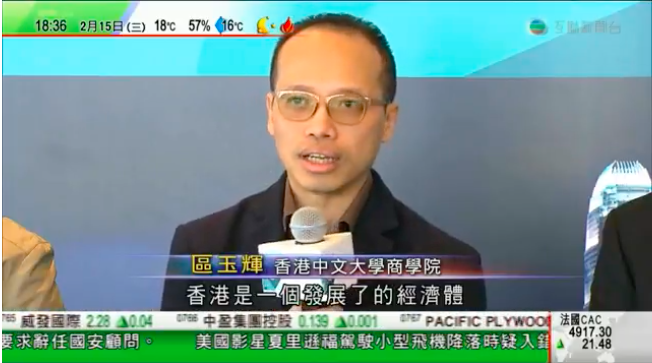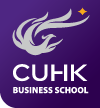Hong Kong and Shenzhen Join Force in Formation of Complementary Advantages to Foster International Competitiveness

In the press conference announcing the Global Entrepreneurship Monitor Hong Kong and Shenzhen Report 2016-17, Prof. Kevin Au advocated Hong Kong and Shenzhen should join force in formation of complementary advantages to foster international competitiveness.
A collaborative effort by The Chinese University of Hong Kong (CUHK) Business School’s Centre for Entrepreneurship (CfE), Hong Kong Baptist University (HKBU)’s School of Business, The University of Hong Kong’s Faculty of Business and Economics, Shenzhen Academy of Social Science and Savantas Policy Research Institute, the research titled “Global Entrepreneurship Monitor (GEM) Hong Kong and Shenzhen Report 2016-17” was released on 15 February 2017.
The report provides a detailed analysis of the current status of entrepreneurship in Hong Kong and Shenzhen and compares the results with past indicators for both ecosystems, using an international benchmark with 65 economies worldwide. It is part of the global initiative, Global Entrepreneurship Monitor (GEM), the world’s foremost comparative entrepreneurship study and a trusted resource on entrepreneurship for key international organizations such as the United Nations, World Economic Forum, World Bank and more.
A press conference was held at KPMG Hong Kong office in Causeway Bay on 15 February 2017 and attended by 30 media organizations, including online and print media outlets, and broadcast media. Participating journalists represented top-tier international media such as Nikkei Asian Review, and a variety of mainstream dailies and broadcast media including: am730, Commercial Radio (Website/Radio) (PDF), HK01 (PDF), Hong Kong Commercial Daily (article 1, 2), Hong Kong Economic Journal (PDF), Hong Kong Economic Times‘s Topick (PDF), Hong Kong Economic Times (PDF), Oriental Daily News (PDF), Ming Pao Daily News, One-TV (Now TV Channel 552), Phoenix TV, South China Morning Post (PDF), TVB, Wen Wei Po (article 1, 2), as well as the most influential mainland Chinese media including China Daily (PDF), China News Service(PDF) and Xinhua News Agency (PDF).
The study collected data from April to November 2016 which involved phone interviews with over 4,000 individuals from Hong Kong and Shenzhen to evaluate the intensity and types of entrepreneurship in general population. The GEM Hong Kong and Shenzhen Report 2016-17 shows that the start-up rates recorded a staggering increase in Hong Kong and Shenzhen from 2009 to 2016. In mid-2016, the early-stage entrepreneurial activity among the adult population was estimated at 9.44 percent (3.64 percent in 2009) in Hong Kong and 16.04 percent (4.8 percent in 2009) in Shenzhen.
Shenzhen has topped Hong Kong in terms of early entrepreneurship rate, venture capital size and informal investment prevalence rate. “A high entrepreneurship rate is not necessarily a good thing. It could mean that there are no better opportunities in a developing economy,” said Kevin Au, Associate Professor of Department of Management and Associate Director of CUHK CfE at CUHK Business School in the press conference.
Commenting on the question: “Can Hong Kong rival Shenzhen as a top innovation hub for startups?”, Prof. Au said: “Hong Kong need not be Shenzhen. Shenzhen is likened to the Silicon Valley, while Hong Kong is likened to New York in the United States. The former specializes in research and development of cutting-edge technology, while the latter focuses on growing new markets and product innovation.”
“Hong Kong firms have the advantages of better access to global markets, greater intellectual property and legal protection, while Shenzhen is strong in manufacturing capabilities and government support,” added Prof. Au. “It will be a unbeatable duo if Hong Kong and Shenzhen can join forces and complement one another.”
The press-meet has resulted in 37 news articles to date, and the China News Service, Xinhua News Agency, Xinhua News Agency’s Asia Pacific Daily (article 1, 2), Southern Daily (PDF) and Wen Wei Po articles were also widely picked up by online general news and business news portals in China, adding an extra of 78 coverage including The People’s Daily (PDF), CCTV.com, NetEase (PDF), Sina (PDF), Sohu (PDF), 21st Century Business Herald, iFeng.com (PDF), Economic Daily (PDF), Guangzhou Daily, Global Times, China Review News (PDF) and more.
In addition, the Marketing and Communications Office at CUHK Business School disseminated a press release on February 15 to more than 1,147 journalists/13,202 distribution points in the United States and 21 countries in Asia Pacific to maximize the overseas publicity of the GEM report. As a result of this successful media campaign, the press release has been widely picked up by the media around the world with at least 301 clippings generated so far.
The original stories are written in Chinese, except the Nikkei Asian Review, China Daily and South China Morning Post ones.
Source:
(International) Nikkei Asian Review
(Hong Kong) Commercial Radio, e-zone, HK01, Hong Kong Economic Times – TOPick (PDF), Oriental Daily News, Phoenix TV (Hong Kong Channel), South China Morning Post, TVB, Wealth Magazine, am730, Hong Kong Commercial Daily, Hong Kong Economic Journal, Hong Kong Economic Times, Career Times – CTgoodjobs and Wen Wei Po
(China) China Daily, China News Service, Hong Kong China News Agency (PDF), One-TV (Now TV Channel 552), Xinhua News Agency, Xinhua News Agency – Asia Pacific Daily, Chinalin Securities (PDF), Comnews.cn (PDF), China Review News, Southern Daily, China.com.cn (PDF), China Daily (Chinese Edition) (PDF), Sina, NetEase, iFeng.com, CCTV.com, 21st Century Business Herald, Economic Daily, Global Times, Sohu, Hexun.com (PDF), The People’s Daily, China Youth Daily (PDF) and more.
Date published: 15, 16 & 17 February, 2017

